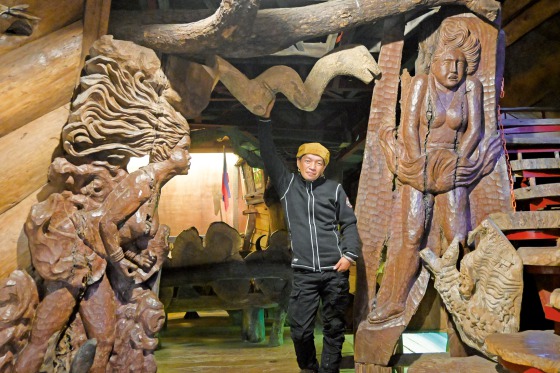
Christopher Atiwon
イフガオ伝統の木彫り作家・アーティスト。1983年バギオ出身。
Traditional Ifugao wood carving artist
Born in Baguio, in 1983
アーティストビレッジ「イリリカ」のミニシアターの入り口にて、アティウォンさんの数少ない手元にある作品とともに。
イフガオの風の精霊インハビアン(左)が風を起こし、マリリン・モンロー(右)のスカートが吹き上がっている。
映画『七年目の浮気』の有名なシーンでもあり、伝統芸術対ハリウッドの文化的対立を表しているという。
Christopher Atiwon with his works at Ili-Likha artist village, Baguio. These works show the Ifugao goddess of wind “Inhabian” (left) blowing Marilyn Monroe’s skirt (right), a famous scene from the movie “The Seven Year Itch.”
It is said that these wood carving arts symbolize the cultural conflict of traditional art versus Hollywood.
イフガオ伝統の木彫り工芸の発祥は、イフガオ州フンドゥアン町ハパオ。遠い昔、生活のための木皿やボウル、家具を木で作っていたのが始まりです。米国統治時代、米軍基地だったキャンプ・ジョン・ヘイの近くでお土産として売るために多くのイフガオ木彫り職人が移住してきたことで、バギオでも木彫り工芸が盛んになりました。
ハパオ出身の両親がお土産用の木彫り作品を作っていた影響で、私は11、12歳で木彫りを始めました。これまで作った作品数は数え切れず、バギオのアーティストビレッジ「イリリカ」にある数点を除き、買っていただいた作品は今どこにあるかも分かりません。
伝統に根差し、作品を進化させる
木の堅さや材料、大きさにもよりますが、1つの作品の制作時間は約4日。速いと驚かれます。制作過程で使う機械はチェーンソーのみで、ほかは全て手作業。ただすばらしい作品を完成させることだけを考え、ひと彫りひと彫り進めていきます。私の作品の題材やアイデアの多くは、イフガオに伝わるおとぎ話や幼少期に祖父母から聞いた話を基にしていますが、すべてオリジナルです。1つとして同じ作品はありません。また、フィリピンはキリスト教徒が多い国ですが、特定の注文を受けた際にしかキリスト教のモチーフは反映しません。するとしても、必ず自分なりに解釈したおもしろいと思うものを作品に落とし込みます。
イフガオの伝統的なテクニックとスタイルをベースに、試行錯誤と進化を重ねてきました。私にはバギオで育ち、活動してきた環境や経験がある。それが発祥地ハパオの作家の作品とはひと味違う特長として作品に表れていると思います。
私は自分を「職人」ではなく「アーティスト」だと認識しています。自分が影響を受けたような、もともとアーティストだった先人たちの中には、生活道具を制作する本来の職人にシフトした人も多い。そうした先人たちが、今度は、イフガオの伝統を重んじつつも新しい私の作品やスタイルを見て、芸術の世界に戻ってきている。おもしろいことに、互いに影響し合っているんです。
自然環境と技術を次世代へ
現在の自分のスタイルを確立したのは約10年前。それまでは主に新しく切った1本の木から1つの作品を生み出していましたが、環境のことを考え、次世代に自然を残すために、制作で余った部分や木以外の廃材をつなげて制作することも増えました。特に台風の後は自分の足で歩き回り、使えそうな倒木や折れた枝を集めます。
海外のアートイベントへの招待も少なくないのですが、ほとんど断っています。ここバギオにいるのが心地良く、芸術活動をするにも一番良いからです。
今後は、観光客向けのお土産品づくりをメインとしているハパオの若い木彫りの職人たちに、伝統の技術や自由な制作のアイデアを伝える活動もしていきたいと思っています。特に子どもたちに木彫りのすばらしさを発見してほしい。そして、私はこれからも作品を作り続け、イフガオの伝統を世界に広げていく使命を全うします。私の作品の進化と発展はまだまだ続きます。
Evolving His Traditional Wood Carving Arts in Baguio
Ifugao traditional wood carving was originated not in Baguio but in Hapao, Hungduan in Ifugao. The beginning was creating kitchenware and furniture for daily lives. It flourished in Baguio during the U.S. occupation when many woodcarvers moved to the area near Camp John Hay to sell their works as souvenirs.
I started learning Ifugao wood carving from my parents from Hapao, when I was 11 or 12 years old.
It takes about four days to finish creating one work. Other than using chainsaws, everything is done by hand. The only thing in my mind when I’m carving is to nicely create beautiful, amazing work. Most of my ideas are based on Ifugao folk tales but I remake them all original. I reflect Christianity only when I get a specific order, and incorporate my own interpretations into my art.
I have kept evolving my technique and style with respect to the Ifugao tradition. What makes my work different from artists in Hapao is my accumulated experience in Baguio.
I see myself as an “artist.” What is interesting is that pioneers or ancestors I was influenced by and I are now influencing each other.
I used to cut trees for my work but since I established my style ten years ago, in order to preserve nature for the next generation, I use wasted materials and assemble them.
Nothing is more comfortable to me than living here in Baguio. I would like to share my traditional skills and creative free ideas with the young wood carvers in Hapao, where producing souvenir goods for tourists has become the main purpose of wood carving. I will do my best to fulfill my mission to spread the Ifugao tradition throughout the world. My challenge to keep evolving my work as an Ifugao artist never ends.















